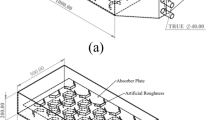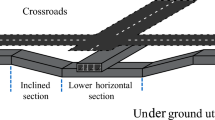Abstract
In this paper, the averaged reentering rates of the densely built cooling towers, which form banks on the building roof in Seoul, Korea have been predicted by a numerical method according to various summer wind conditions and roof wall types. The averaged reentering rates of all the cooling towers are compared according to two wall types to study the effect of the intake outdoor air louver on the reentering rates. Consequently, two findings are drawn as follows. (1) With a curtain wall, the averaged reentering rates of the total cooling towers against the west and the south wind at ν = 5 m/s are 13.3 and 24.4%, respectively. Therefore, it is strongly needed to find a method to reduce the reentering of the discharged air from the cooling towers. (2) In the case of a louver wall, the averaged reentering rates of the cooling towers with the west and south wind at ν = 5 m/s are 2.5 and 9.74%, respectively, which have been estimated to be lower than those of the curtain wall. Therefore, the louver wall can be suitably adopted to reduce the reentering of the discharged air from the cooling towers in the present study.










Similar content being viewed by others
Abbreviations
- C μ , C 1ε , C 2ε :
-
coefficients in the turbulence model
- g :
-
gravity (m/s2)
- G k :
-
generation of turbulent kinetic energy due to mean velocity gradients (kg/m s3)
- G b :
-
generation of turbulent kinetic energy due to buoyancy (kg/m s3)
- k :
-
turbulent kinetic energy (m2/s2)
- P :
-
pressure (Pa)
- G :
-
mass flow rate of air (kg/s)
- L :
-
mass flow rate of circulating cooling water (kg/s)
- N b :
-
number of cooling towers in each bank
- N t :
-
number of total cooling towers
- q :
-
heat flux per unit area (W/m2)
- R ct :
-
reentering rate of individual cooling towers (%)
- \( \overline{R} \) :
-
averaged reentering rate of banked cooling towers (%)
- \( \widetilde{R} \) :
-
averaged reentering rate of total cooling towers (%)
- T :
-
temperature (K)
- u, v, w :
-
velocities in x-, y-, z-directions (m/s)
- x, y, z :
-
Cartesian coordinates (m)
- Sc t :
-
Schmidt number
- D :
-
mass transfer coefficient (m2/s)
- NE-, NW-, S-, W:
-
bank names of cooling tower groups identified by installation location
- x :
-
mole fraction of water vapor [kg/kg Dry air (DA)]
- β :
-
coefficient of volumetric thermal expansion (K−1)
- ε :
-
dissipation rate of turbulent kinetic energy (m2/s3)
- μ l :
-
laminar viscosity (kg/s m)
- μ t :
-
turbulent viscosity (kg/s m)
- ρ :
-
density (kg/m3)
- σ t :
-
turbulent Prandtl number
- a:
-
entering air
- i, j :
-
tensor components
- o:
-
outdoor air or ambient air
- w:
-
circulating cooling water
- r:
-
reentering air
References
Yoon JH (2003) The method of performance test and state of the equipment construction of the cooling tower. In: The magazine of the Society of Air-Conditioning Refrigerating Engineering of Korea, vol 32, no 12, pp 45–52
Kwan OI (2003) The method of improvement for the performance of existing cooling towers. In: The magazine of the Society of Air-Conditioning Refrigerating Engineering of Korea, vol 32, no 12, pp 38–45
Chan TL, Hsu ST, Lind JT, Hsu KH (1974) Plume recirculation and interference in mechanical draft cooling towers, IIHR Report No, 160, Iowa institute of hydraulic research. The University of Iowa City, Iowa
Moore RD, Wheeler DE, Wilber KR, Johson AE (1979) An evaluation of schemes for the prediction of recirculation on crossflow rectangular mechanical draft cooling towers, TP79-09. Cooling tower institute, Houston
Cooper JW (1984) Recirculation and interference characteristics of circular mechanical draft cooling towers, TP84-13. Cooling Tower Institute, Houston
Niemann H-J, Kopper H-D (1998) Influence of adjacent buildings on wind effects on cooling towers. Eng Struct 20(10):874–880
Krger DG (1989) Reduction in performance due to Recirculation in mechanical draft cooling towers. Heat Transf Eng 10(4):37–42
Partankar SV (1980) Numerical heat and fluid flow. McGraw-Hill, New York
Chen Q, Srebric J (2002) A procedure for verification, validation, and reporting of indoor environment CFD analyses. HVAC&R Res 8(2):201–216
Xue H, Chou SK, Zhong XQ (2004) Thermal environment in a confined space of high-rise building with split air conditioning system. Build Environ 39:817–823
Author information
Authors and Affiliations
Corresponding author
Rights and permissions
About this article
Cite this article
Moon, SA., Lee, TG., Hur, JH. et al. Study on the reentering rates of individual cooling towers installed on a building roof. Heat Mass Transfer 44, 1345–1353 (2008). https://doi.org/10.1007/s00231-008-0373-9
Received:
Accepted:
Published:
Issue Date:
DOI: https://doi.org/10.1007/s00231-008-0373-9




